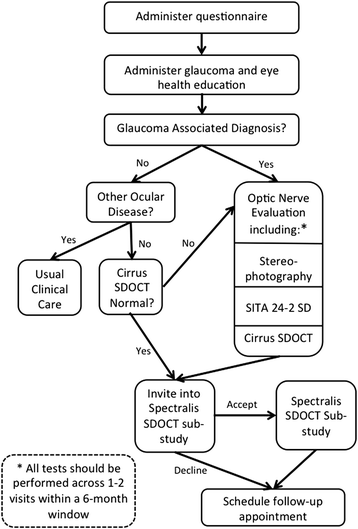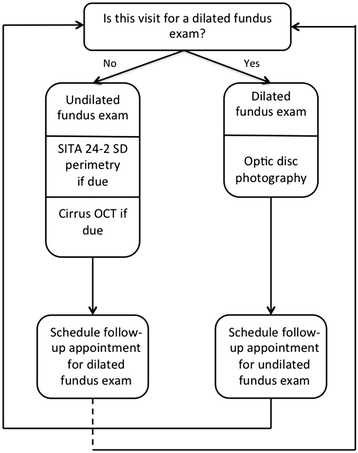Eye Care Quality and Accessibility Improvement in the Community (EQUALITY) for adults at risk for glaucoma: study rationale and design
- PMID: 26582103
- PMCID: PMC4652429
- DOI: 10.1186/s12939-015-0213-8
Eye Care Quality and Accessibility Improvement in the Community (EQUALITY) for adults at risk for glaucoma: study rationale and design
Abstract
Background: Primary open angle glaucoma is a chronic, progressive eye disease that is the leading cause of blindness among African Americans. Glaucoma progresses more rapidly and appears about 10 years earlier in African Americans as compared to whites. African Americans are also less likely to receive comprehensive eye care when glaucoma could be detected before irreversible blindness. Screening and follow-up protocols for managing glaucoma recommended by eye-care professional organizations are often not followed by primary eye-care providers, both ophthalmologists and optometrists. There is a pressing need to improve both the accessibility and quality of glaucoma care for African Americans. Telemedicine may be an effective solution for improving management and diagnosis of glaucoma because it depends on ocular imaging and tests that can be electronically transmitted to remote reading centers where tertiary care specialists can examine the results. We describe the Eye Care Quality and Accessibility Improvement in the Community project (EQUALITY), set to evaluate a teleglaucoma program deployed in retail-based primary eye care practices serving communities with a large percentage of African Americans.
Methods/design: We conducted an observational, 1-year prospective study based in two Walmart Vision Centers in Alabama staffed by primary care optometrists. EQUALITY focuses on new or existing adult patients who are at-risk for glaucoma or already diagnosed with glaucoma. Patients receive dilated comprehensive examinations and diagnostic testing for glaucoma, followed by the optometrist's diagnosis and a preliminary management plan. Results are transmitted to a glaucoma reading center where ophthalmologists who completed fellowship training in glaucoma review results and provide feedback to the optometrist, who manages the care of the patient. Patients also receive eye health education about glaucoma and comprehensive eye care. Research questions include diagnostic and management agreement between providers, the impact of eye health education on patients' knowledge and adherence to follow-up and medication, patient satisfaction, program cost-effectiveness, and EQUALITY's impact on Walmart pharmacy prescription rates.
Discussion: As eye-care delivery systems in the US strive to improve quality while reducing costs, telemedicine programs including teleglaucoma initiatives such as EQUALITY could contribute toward reaching this goal, particularly among underserved populations at-risk for chronic blinding diseases.
Figures
References
-
- Wilson R, Richardson TM, Hertzmark E, Grant WM. Race as a risk factor for progressive glaucomatous damage. Ann Ophthalmol. 1985;17:653–9. - PubMed
Publication types
MeSH terms
Grants and funding
LinkOut - more resources
Full Text Sources
Other Literature Sources
Medical
Research Materials



